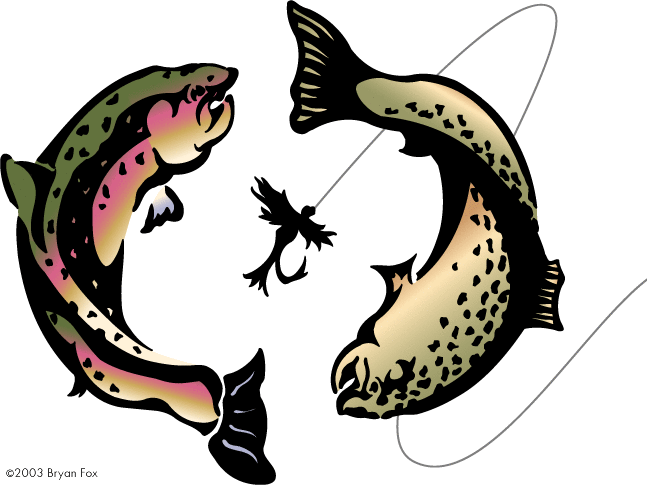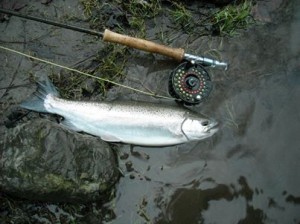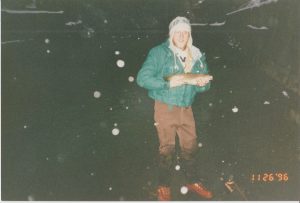Bright December Rainbow Caught Swinging in the Finger Lakes
The winter has evolved into one of my favorite times to fish in central New York. All of my favorite places to flyfish including the tributaries of the Finger Lakes, Lake Ontario and Erie Tributaries and the many beautiful inland trout streams each offer unique and rewarding scenery and fly fishing opportunities during the winter. During warm weather popular fishing areas can be overwhelmed with anglers. The colder temperatures and snow lower the angler pressure and many of the good pools become frequently available to fish in solitude. When I fish the winter, I like to start out swinging streamers or wet flies, before I move to dead drifting flies lower in the water column. I’ve had some really great experiences in the winter catching big browns, rainbows and steelhead on a swinging fly which brings me back to the technique. Swinging flies is easily one of the most satisfying ways to catch any fish.
This Brown was caught on a swinging fly on a dry line at Oak Orchard Creek in the late fall of 1996. It was recommended by an older fly fishing friend of mine to try a Green Butt Skunk and a Fall Favorite while fishing for lake run fish. I hooked this brown on the Green Butt Skunk shortly after I rose a steelhead on a Fall Favorite. My first tributary rod, a custom made switch rod prototype, on the ground next to me. (Photo by a guy at Oak Orchard Creek)
Each fly fisherman’s journey progresses in its own unique way, which is part of the mystique of the sport. Many will stick to fishing solely during the spring, summer and fall dry fly seasons and learning to match the hatch, some will fall in love with nymph fishing and its deep slow presentation and productive nature. My personal fly fishing journey came full circle. It started on the tiny alder strewn tannic streams of the southern Adirondacks and the pristine crystal waters of the Tug Hill Plateau. During those early years of my youth catching a trout seemed like a dream come true. The trout, was very elusive and beautiful to me, and to hook one on a fly rod and bring the fish to hand, I considered a very special experience. During my youth I never had a camera and the experience of catching a trout was a moment shared only with nature. My grandfather was the main influence on my early fly fishing and how he fly fished was exclusively swinging wet flies and dead drifting dry flies in the solitude of an off the beaten path quiet stream. I watched what he was doing and what flies he used and tried to mimic those techniques on other outings with my dad, who didn’t fly fish but was willing to take me fly fishing. As a result my early fly fishing exclusively involved swinging flies on a mono leader and floating line or dead drifting dry flies.
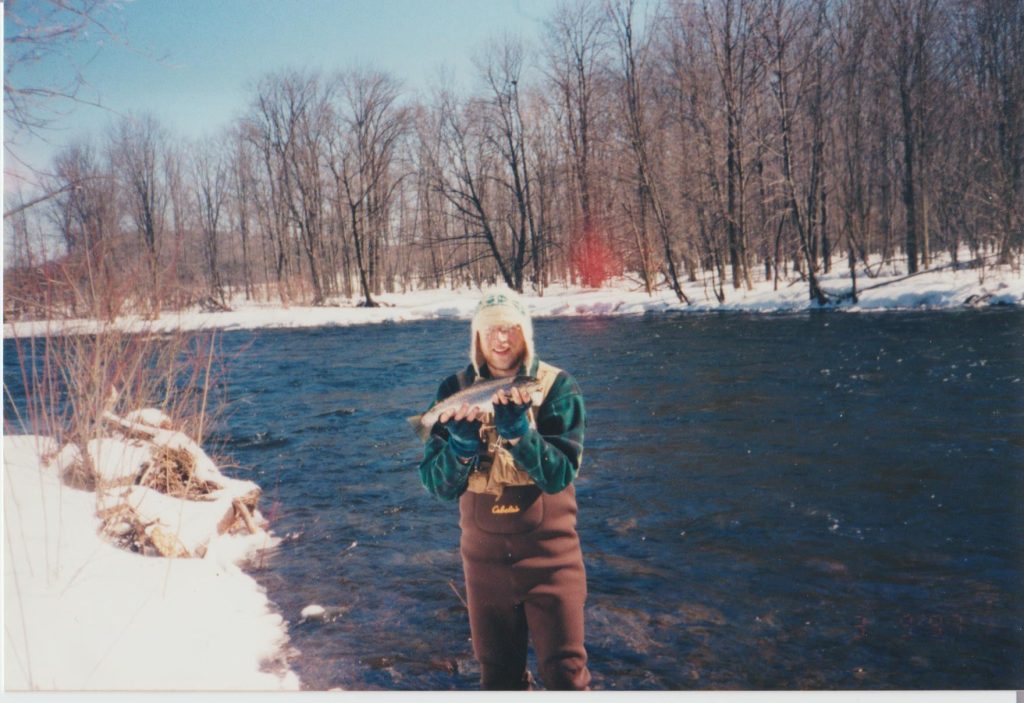
At the Old Farts Pool on the Salmon River in the 90s before the bank behind me eroded away. The water looks gorgeous and many times I fished the upper river in solitude. I caught this bright little fish on a swinging wet fly and my dad who would hike along the river while I fished took this photo. (Photo by Herbert Chapple)
My fly fishing journey started by swinging flies without added weight to the leader. As with many anglers, I had a stint with thinking that fishing near the bottom during the winter would catch more fish and that catching more fish would help fulfill what I was looking for in fly fishing. After many years of swinging flies with a single handed rod, I spent part of one season in 2000 fishing the Lake Ontario tributaries fishing a technique that is now called “Euro Nymphing.” This technique in its early form was used by many guides on the Salmon River in New York. It involved long light rods, a fly reel, a running line, a lot of backing, long leaders and light tippet. Enough weight was added to the leader to get the fly down quickly into deep holes where steelhead hold in the winter and the cast was made using the added weight by flipping the weight and letting excess running line hanging below the reel shoot through the guides. The end result was the weight and the fly, usually an egg or a nymph pattern bumping along the bottom. I stuck it out for a few weeks trying to learn this technique thinking I would catch more fish and I did catch some nice fish but the technique became very annoying and laborious. The line management, the dredging the bottom and the frequent snags of the weight and flies in the boulder strewn river bed of the The Salmon River made actual work out of fishing and I didn’t enjoy loosing flies and line in the river bottom. Sometime in December of that same year, shortly after I started learning this technique, I abandoned it for swinging flies on a single handed rod once again. My first outfit for swinging flies for tributary fish was a custom made switch rod made by a local rod maker named, Steve Payne, who has since passed. He was a pleasant man and suggested I start with a nine and a half foot seven weight rod with a small handle so that I could also cast the line with two hands. I purchased this rod and used it to swing flies on the Lake Ontario tributaries in the nineties before I took my stint with the running line technique. My background swinging , instilled in me by my grandfather, was strong and the urge to swing soon overcame the deep nymphing experiment. Just as I did as a child, once again I was casting a tapered fly line and swinging flies.
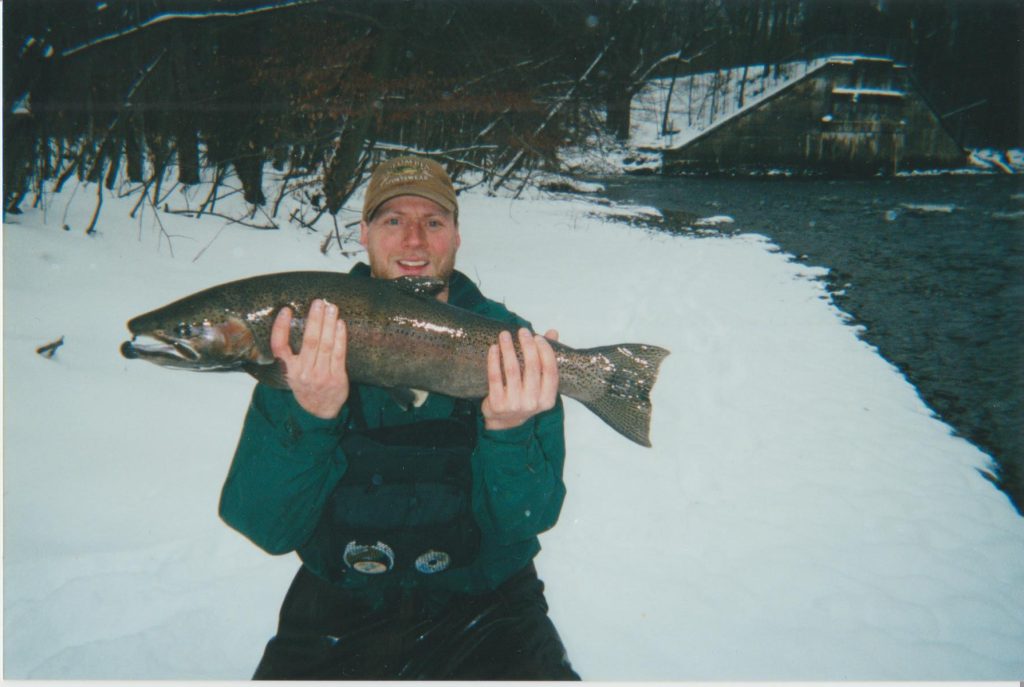
By the Old Trestle, which is now gone, A hefty Male Taken Using Deep Nymphing with a Blue/Black Stonefly. (Photo by Geoff Rule)
After many years of swinging flies with a single handed rod and dead drifting flies using various outfits, mostly 10 foot rods with a floating line and sinking leaders or a modest amount of split shot added to the leader, my friends older brother suggested we try what was called a “Spey Rod.” He was a man of very few words and had many phrases and I always listened to what he said. On one trip to the Salmon River He said “try this,” and a new journey had begun. The first long rod I tried was his 13 foot Orvis Trident Spey rod. I immediately found standard roll casting easier and could easily propel a heavy fly much farther out into the river and the length also made mending line and manipulating the fly through the pools and runs much easier. That first day fishing the long rod prompted me to immediately purchase a twelve and a half foot rod and a bigger reel in order to hold a larger weight forward spey fly line. My first line had a 52 foot head and I did some reading on casts and developed a right handed double-spey and single-spey cast fairly quickly. It felt like I had starting fly fishing for lake run fish all over again, as sort of a re-birth. I initially fished with a mono leader without added weight, in order to learn the casting techniques and progressed to adding a sink tip or a small amount of shot, but eventually over a number of years completely stopped using split shot. Once again I found casting any bit of shot, changed the dynamics of the cast, and the casting became less pleasant. I now fish solely with outfits rigged with floating weight forward lines, or floating shooting heads, and either a “dry” monofilament leader or a sinking leader.
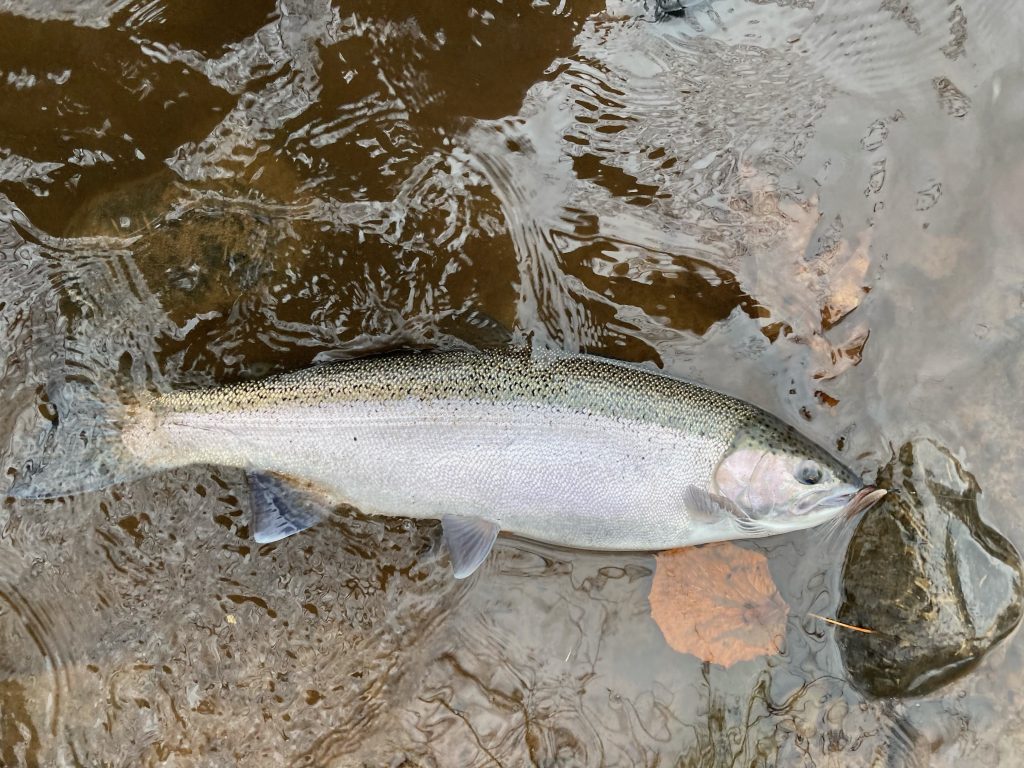
This beautiful fish took a Lady Caroline Atlantic Salmon Fly in the late autumn of 2024 using a light sink-tip and mid-belly Spey line. (Photo by Matt Chapple)
There are many ways present a swinging a fly. The technique is dictated by the size of the fish, water conditions, size of the creek or river and also personal preference. One simple set-up I use for medium sized tributaries of the Great Lakes or the Finger Lakes consists of a 10 or 11 foot 7 weight single handed rod, an 8/9 weight floating weight forward line, a 9 foot tapered monofilament leader, a 3 foot tippet and a weighted or bead head fly. I always use a tippet of 8 pound Maxima Ultragreen or greater which helps absorb the shock of an aggressive take and helps fight a big fish. One presentation that has been effective, is to cast across or just slightly upstream keeping in mind the down stream spot you want the fly to swim through. As the line drifts down stream, I put some subtle mends in the line allowing the fly start sinking and keeping the fly line relatively straight by removing downstream bows in the line caused by the current between you and the fly. As the line moves downstream follow the line with the tip of the rod pointed at the fly. When the line gets to about a 45 degree angle downstream of you, gently tighten and cease mending the line and let the fly swim across the stream. Fish will often take the fly as it first starts to move across the current. Try to envision the fly under water while also watching the fly line so you can swim the fly through areas where you predict fish to be holding. When the fly is done swimming across the stream leave it to dangle in the current directly below you for up to 10-20 seconds. Its possible that a fish may have become interested in your swimming fly and may still be eager to rise up and take the fly. When the fish strike the fly using this technique there will be no doubt its a fish as the line will instantly tighten.
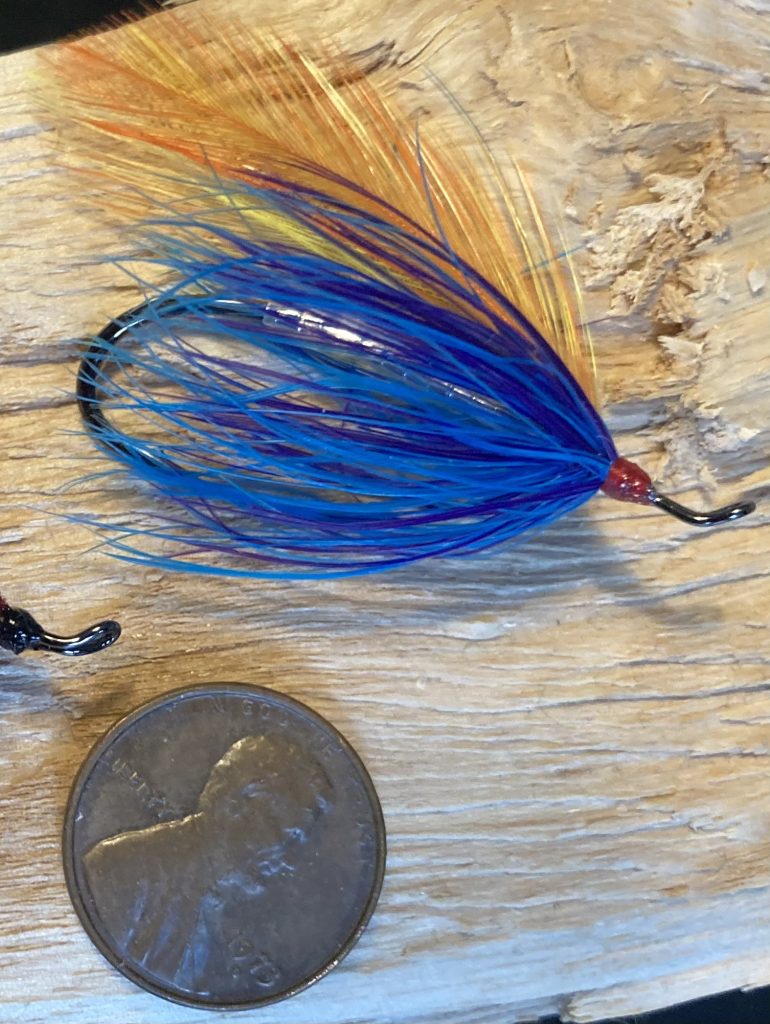
A slight variant of the “Winter’s Hope” , without the olive calf-tail, which I have used to catch fish in the dead of winter in central New York.
Another technique that I use to swing flies uses a twelve and a half foot spey rod, a mid-belly or long-belly spey line and a light sinking leader. This is a nice combo for the Salmon River during lower water periods or in the autumn or spring, when the water is a bit warmer. I enjoy fishing unweighted heavy wire single hook marabou or feather-wing flies on this outfit. I have found that the feather-wing flies sink better than hair-wing flies and let the fly get a little further down in the water column without adding a heavier leader. A slight adaptation to a very good winter fly called “Winter’s Hope,” developed from a hair-wing version to a feather-wing version by the famous steelhead fisherman and conservationist, Bill McMillan, has proved to sink well and produce fish on the Salmon River. I love to fish this fly on the Salmon River during lower water periods in the winter on a medium or light sink tip and have caught many fish swinging the fly in the dead of winter.

I caught this beautiful colored male fish in the beginning of March, before the snow started to thaw, on a Winter’s Hope fly tied on a heavy steelhead iron. (Photo by Matthew Chapple)
Lastly, when the water is a bit higher or I become interested in fishing a heavier fly such as an intruder or heavily weighted fly, I will switch my outfit to a 14 foot 9 weight rod and a shooting head with a heavier sink tip. Shooting heads allow the angler to cast a much heavier tip and fly together and facilitates a more quickly sinking fly. Many fly fisherman will continue to fish nymphs and egg patterns during the winter but you never know when fresh fish will enter the river and even fish that have been holding in the river will sometimes find a bigger fly interesting enough to strike as the fly swims by them or hesitates enough for them to swim upstream slightly and grab the fly.
